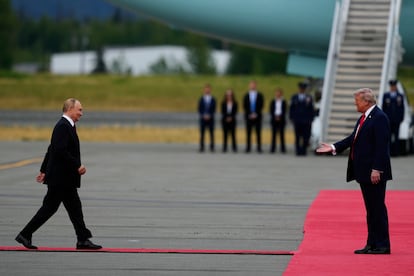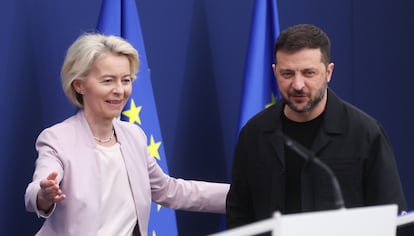Just hours before his meeting at the White House on Monday, a key meeting for Ukraine's future, US President Donald Trump increased the pressure on Ukrainian leader Volodymyr Zelensky. In a message on his social network, Truth, the Republican urged his counterpart to accept peace with Russia. He also clarified that kyiv cannot aspire to"recover Crimea," the peninsula that Russia occupied in 2014, nor"join NATO."
According to the public schedule distributed by the White House late Sunday, Zelensky and the European allies accompanying him will arrive at the US president's residence at noon Washington time (6:00 p.m. Spanish time). Trump will hold a one-hour bilateral meeting with the Ukrainian at 1:15 p.m. in the Oval Office. This will be followed by a family photo, followed by a meeting with the visiting leaders at 3:00 p.m. This last meeting will take place in the East Room, the largest in the residential area of the White House: in the entire West Wing, where executive functions are conducted, there is no room large enough to accommodate them all.
In his social media message, Trump shifts the responsibility of ending the war to Zelensky. The Ukrainian leader"can end the war with Russia almost immediately if he wants, or he can keep fighting," Trump wrote, echoing a sentiment he had previously expressed after his summit with Vladimir Putin in Alaska on Friday. He had then asserted that"it is now up to President Zelensky to deliver [a peace agreement]."
"Remember how it all started. Not getting back the Crimea Obama gave us 12 years ago and not letting Ukraine join NATO. Some things never change!" the US president added in his Sunday address.

Kremlin demands
The meeting with Zelensky comes three days after his meeting with Putin. After the meeting, the US president appears to have once again accepted Moscow's demands. Trump announced that he is no longer demanding a ceasefire as a prelude to negotiations, as Ukraine and the Europeans had demanded, something the Russian had shied away from accepting.
It later emerged that the plan that the Russian autocrat – feted by Trump in Alaska as an equal – presented to the American, and that the latter conveyed to the Western allies, proposes taking complete control of Donbas (the provinces of Lugansk and Donetsk), including the areas under the control of Ukrainian forces, in exchange for freezing the front line.
Putin also insisted in his statement after the meeting that ending the conflict requires addressing"the causes of the war." With this statement, Moscow is demanding a definitive blockade of Ukraine's entry into NATO and a drastic restriction on Western arms supplies to the occupied country.
Zelensky arrived on Sunday evening for a key meeting on his country’s future, where he and the Europeans want to emphasize the need for Ukraine to receive credible security guarantees in any kind of peace agreement. In a message on the social network X, he declared that peace “must be lasting. Not like years ago, when Ukraine was forced to give up Crimea and part of Donbas, and Putin simply used it as a platform for his next invasion.” “Russia has to be the one to end the war it started,” the Ukrainian leader said.
The president is appearing in Washington accompanied by a long list of European leaders to support him: European Commission President Ursula von der Leyen; German Chancellor Friedrich Merz; the presidents of France, Emmanuel Macron, and Finland, Alexander Stubb; as well as Italian Prime Minister Giorgia Meloni; British Prime Minister Keir Starmer; and NATO Secretary General Mark Rutte.

In a second message on his social media accounts, Trump referred to the visit of the European leaders:"Great day at the White House tomorrow. We've never had so many European leaders at once. It's a great honor to welcome you!"
The European allies want to ensure that the Ukrainian doesn't receive the same treatment he received six months ago, during his last visit to the Oval Office, when Trump and Vice President J.D. Vance publicly rebuked him for seeking help against Russia. They also want to make clear to the Americans their position of solidarity with Ukraine and their rejection of Putin's plan, and demonstrate their unity so that the end of the invasion isn't a decision between Washington and Moscow that Ukraine has no choice but to accept. Almost all European countries—especially those closest to the Russian border—understand that the continent's security depends on Ukraine's future.

